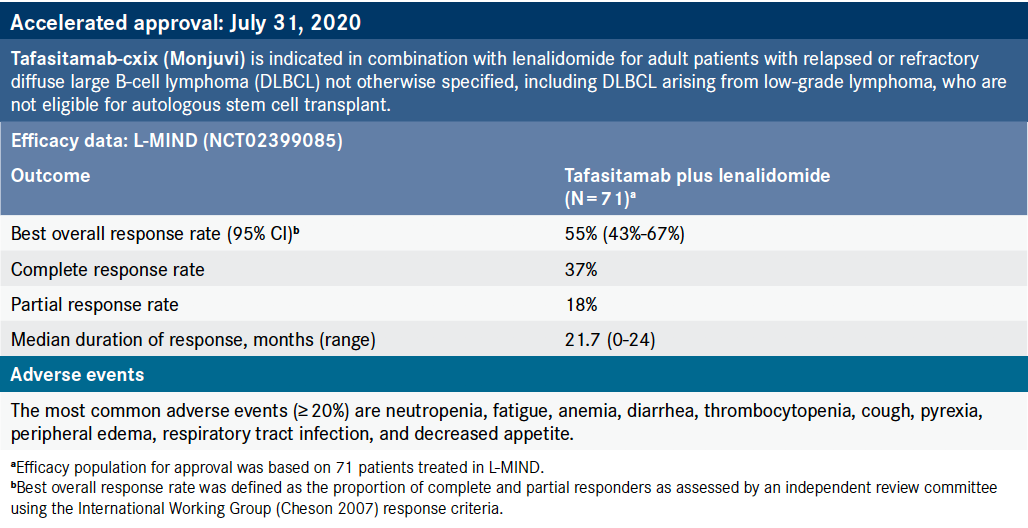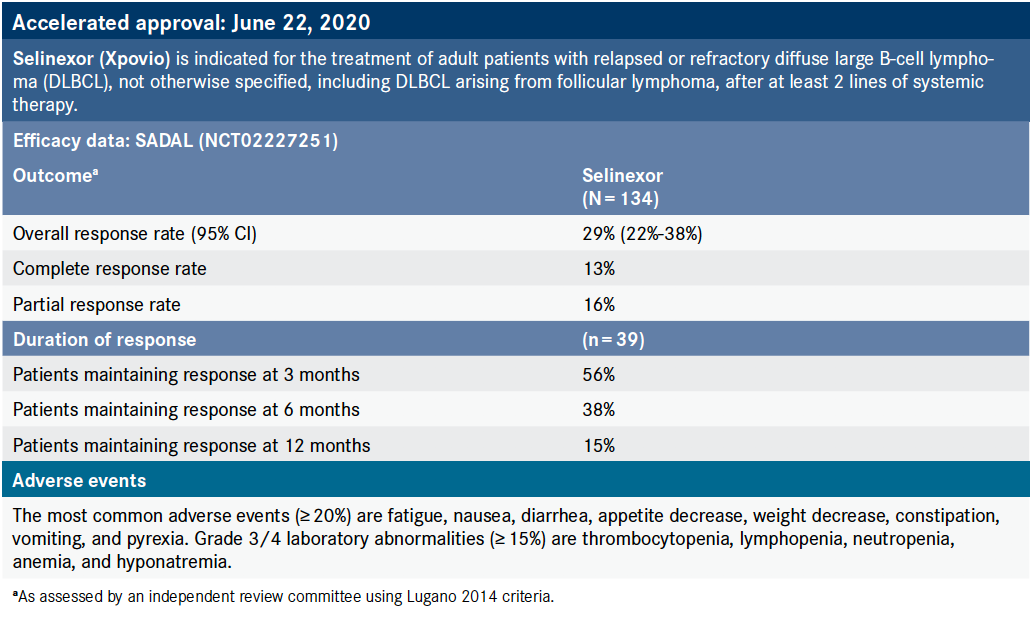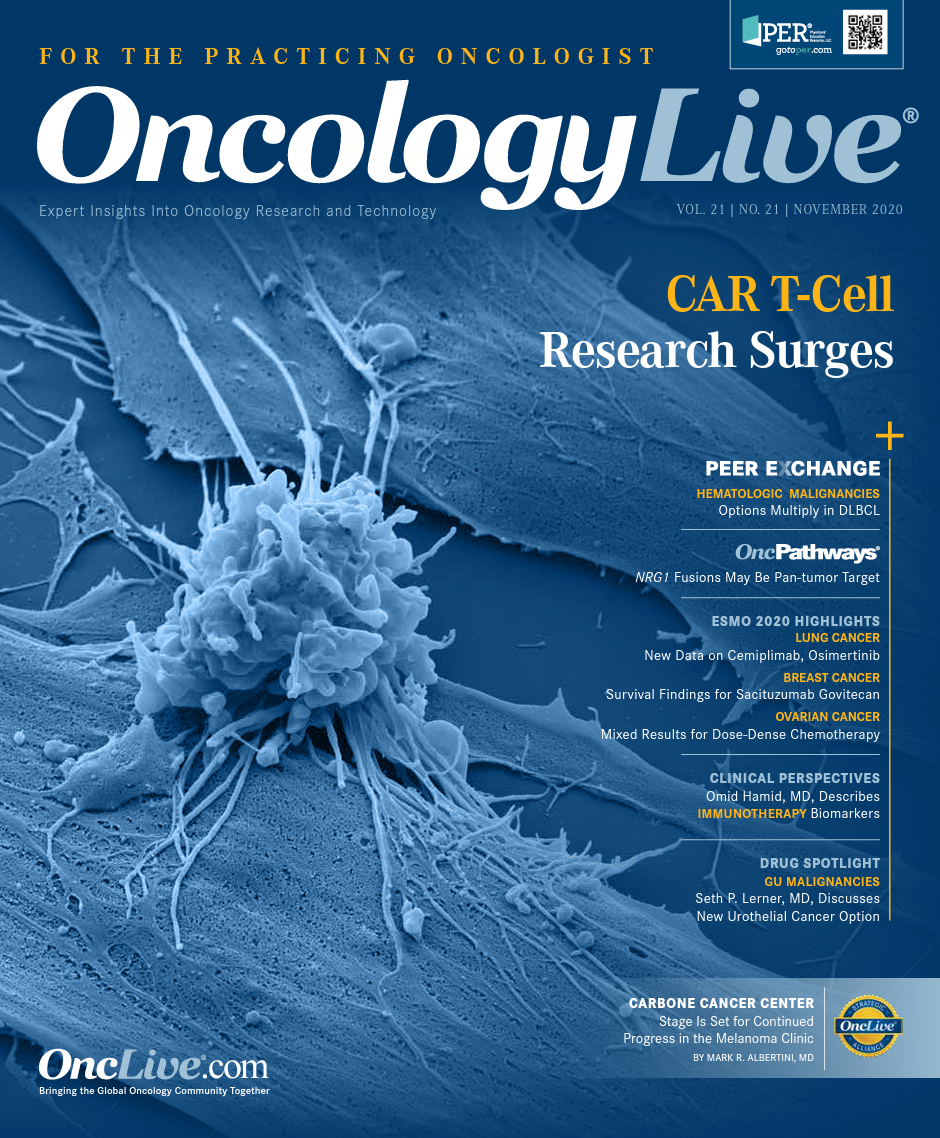Publication
Article
Oncology Live®
Making Progress Against Relapsed/ Refractory DLBCL Without CAR T
Author(s):
A panel of lymphoma experts discuss several novel agents for relapsed/ refractory diffuse large B-cell lymphoma, some of which have been recently approved.
John P. Leonard, MD

Approximately of patients with diffuse large B-cell lymphoma (DLBCL) experience refractory disease after initial treatment or have a relapse after achieving remission.1 Until the advent of chimeric antigen receptor (CAR) T-cell therapies, treatment options for these patients had been mostly palliative, especially for those ineligible for autologous stem-cell transplantation (ASCT) and those who relapsed after ASCT. Although CAR T-cell therapies have revolutionized the treatment landscape for relapsed/refractory (R/R) DLBCL, not all patients are candidates for this treatment. Of those who do receive it, 30% to 35% experience long-term benefit, demonstrating a great unmet need for others in the treatment landscape.
Emerging agents have started to shake up the R/R DLBCL armamentarium, but there is still a long road ahead to fully define their role. During an OncLive Peer Exchange®, a panel of lymphoma experts discussed several novel agents for R/R DLBCL, some of which have been recently approved. They examined the clinical trial data, discussed how these agents compare with CAR T-cell therapy, and provided insights on how they might be used in clinical practice. “Before long, we’ll need more sophistication in how we approach patients,” moderator John P. Leonard, MD, said. “Hopefully, that means we’ll be using treatments more effectively and have more tools at our disposal.”
Tafasitamab-Cxix
Tafasitamab-cxix (Monjuvi) is a humanized anti-CD19 monoclonal antibody that has been mostly studied as a combination therapy, particularly with lenalidomide (Revlimid). On July 31, 2020, the FDA granted accelerated approval to the combination for adult patients with R/R DLBCL not otherwise specified, including DLBCL arising from low-grade lymphoma, who are not eligible for ASCT.2
“The Fc portion has been enhanced to increase ADCC [antibody-dependent cell-mediated cytotoxicity] and ADCP [antibody-dependent cellular phagocytosis],” Kami J. Maddocks, MD, said. She noted that investigators initially examined tafasitamab in a single-arm study as monotherapy in patients with R/R non-Hodgkin lymphoma, the data from which demonstrated responses in DLBCL, including a few complete responses (CRs). In this phase 2a study (NCT01685008), investigators observed responses in 9 of the 35 patients (26%) with DLBCL (2 CRs and 7 partial responses [PRs]), with a median duration of response of 20.1 months (range, 1.1-26.5).3 “[This study] signaled that there might be some activity with this agent in large cell lymphoma,” Maddocks said. She proceeded to explain that the rationale for combining this agent with lenalidomide is that lenalidomide activates natural killer cells, thereby optimizing the tumor environment for tafasitamab.
Data from L-MIND (NCT02399085) provided the basis for the approval of tafasitamab in combination with lenalidomide. The phase 2, open label, multicenter, single-arm trial included 71 patients with DLBCL who received tafasitamab 12 mg/kg intravenously (days 1, 8, 15 and 22 of each 28-day cycle for 3 cycles, then days 1 and 15 only) with lenalidomide 25 mg orally (days 1-21) for a maximum of 12 cycles, followed by biweekly tafasitamab as monotherapy.4 “It was really targeted at those patients who relapsed after their initial therapy or maybe received a first salvage and then were not candidates for ASCT,” she said. All patients in the study had previously received 1 to 4 systemic regimens, at least 1 of which was an anti-CD20 therapy.4
Maddocks noted that the combination was well tolerated and that the adverse effects (AEs) were in line with expected AEs for lenalidomide monotherapy. The most common grade 3 or higher treatment-emergent AEs were hematologic abnormalities, including neutropenia (48%), thrombocytopenia (17%), and febrile neutropenia (12%).4 “There were very few infusion-related reactions. Approximately three-quarters of the patients were able to stay on lenalidomide 20 mg or higher,” Maddocks said.
Tafasitamab/Lenalidomide vs CAR T-Cell Therapy
The panelists proceeded to discuss tafasitamab plus lenalidomide in the context of CAR T-cell therapy and when it might be most useful. They noted that the patients in the L-MIND trial were not heavily pretreated, were not refractory to their first-line treatment, and did not have more aggressive disease subtypes, such as double- or triple-hit biology.
Subsequently, this population was different from those included in the CAR T-cell studies, such as ZUMA-1 (NCT02348216), JULIET (NCT02445248), and TRANSCEND-NHL-001 (NCT02631044), in which 77%, 54%, and 67% of patients, respectively, had primary refractoriness, and 69%, 51%, and 50% received more than 3 lines of therapy.5 Further, in reported data from the JULIET and TRANSCEND-NHL-001 studies, 27% and 22% of patients had double-hit lymphoma, respectively. “[CAR T-cell therapy] doesn’t care that you’re a double-hit. You can still respond and have durability. It’s the same thing if you’re primary refractory,” Matthew Lunning, DO, said. Thus far, there are no data to clarify whether this is also the case for tafasitamab plus lenalidomide.
It is also unknown whether tafasitamab plus lenalidomide can be used as a bridge to CAR T-cell therapy. National Comprehensive Cancer Network guidelines state, “It is unclear if tafasitamab will have a negative impact on the efficacy of subsequent anti-CD19 CAR T-cell therapy.”6 Lunning said that preclinical data have shown that there is no negative affect with tafasitamab.
“[Cell line studies show] that it does engage the same CD19 antigen that you’d expect the CAR T cell to go after but, at least in cell lines, it did not appear to affect the CAR T cells,” he said. Maddocks added that there was 1 patient enrolled in the L-MIND trial who received CAR T-cell therapy after progression on tafasitamab plus lenalidomide and who has been in remission for more than a year. However, she warned that you cannot draw conclusions based on 1 patient. “As this combination becomes available to people, we’ll hopefully know more about whether there is an effect on the efficacy of CAR T,” she said.
Approval Snapshot Tafasitamab-cxix2

Despite the unknown effect of tafasitamab plus lenalidomide as a bridging therapy to CAR T, the panelists agreed this may be a reasonable use. “If it takes a couple of weeks to get patients to their apheresis and then another 3 weeks to get them [to delivery], maybe tafasitamab is the best option. It’s 8 weekly doses early on and you’re getting drug exposure with the intent to go to CAR T-cell therapy or a patient could say no, and you haven’t lost anything if they’re responding,” Lunning said.
Lunning suspects tafasitamab plus lenalidomide will get a lot of use because “it is an IV [intravenous] therapy, given weekly for a lot of doses up front, and lenalidomide is an oral therapy that people are very comfortable using in lymphoma and multiple myeloma.” Subsequently, he emphasized the importance of capturing the data for those patients previously exposed to tafasitamab/lenalidomide who do not respond or who get a PR and go on to CAR T-cell therapy to determine the true durability of the combination. “That’s only going to come out with real-world experience data rather than a commercially funded experience,” Lunning said.
Selinexor
The FDA granted selinexor (Xpovio) accelerated approval on June 22, 2020, as a single agent for adult patients with R/R DLBCL, not otherwise specified, including DLBCL arising from follicular lymphoma, after at least 2 lines of systemic therapy.7 The oral agent represents a whole new class of drugs. “It’s unlike anything that we have for large cell lymphoma or any other cancers. It’s called a SINE [selective inhibitor of nuclear export] and it targets certain proteins that are exported out of the nucleus that give cells a prosurvival advantage. It is not necessarily specific to large cell lymphoma, but it targets the mechanism that large cell lymphoma probably uses to keep itself alive and potentially resistant,” Nathan H. Fowler, MD, said.
The drug’s approval was based on data from SADAL (NCT02227251), a multicenter, single-arm, open-label phase 2b trial in which 134 patients received selinexor 60 mg orally on days 1 and 3 of each week. All patients in the study had previously received 2 to 5 systemic regimens. Thirty-nine patients (29%) responded, with 18 (13%) achieving a CR and 21 (16%) achieving a PR.8 Unlike the L-MIND study, SADAL included patients with double- or triple-expressor status and data showed responses in these patients. “If you think about [selinexor in the context of] CAR T-cell data and others, it’s not quite as good, but it’s a single drug so it’s fairly easy to give. It is effective in a subset of patients with large cell lymphoma that is pretty difficult to treat, including patients who have double-hit lymphoma,” Fowler said. He also noted that responses appear durable. “If you look at patients who have PR or better, the duration of response is over 2 years, [so] there is a select group of patients who do achieve durable benefit with the drug,” he explained.
A challenge with selinexor is its toxicity. The most common grade 3 and 4 AEs observed in the SADAL study included thrombocytopenia (49% and 18%, respectively), neutropenia (21% and 9%), fatigue (grade 3/4, 15%), and nausea (grade 3/4, 6%).7 Maddocks said that in her experience gastrointestinal toxicity was most problematic but once this was addressed with antiemetics, it became less concerning. The FDA recommends that selinexor be administered with antiemetic prophylaxis.7
Approval Snapshot Selinexor7

The panelists emphasized that selinexor is not a replacement for CAR T-cell therapy but added that it may help fill an unmet need for patients who have limited treatment options. “For patients who are failing [ASCT or CAR T], we don’t have a lot of options. We can do lenalidomide and lenalidomide plus a CD19-targeted agent. Patients who fail CAR T-cell therapy, those who would not qualify [for CAR T], and those who are not near a [CAR T] center are the obvious population [for selinexor],” Fowler said. Maddocks and Lunning agreed.
Emerging Treatments and Trends
The panelists noted that many other agents are in clinical trials for R/R DLBCL, including bispecific antibodies such as glofitamab and epcoritamab. “[These are] going to be generating data but not a lot of data will follow [treatment with] CAR T,” Lunning said. Nevertheless, he is excited to see what kind of durability these drugs will ultimately show. In contrast, another investigational bispecific antibody, mosunetuzumab, has shown favorable efficacy in a phase 1/1b study that included patients with heavily pretreated R/R DLBCL, including those with disease progression after CAR T-cell therapy. Of the 7 evaluable patients with DLBCL who received prior CAR T-cell therapy, 2 achieved a CR.9
“When we were looking at the BiTE [bispecific T-cell engager] molecules a couple of years ago, there was some sense that they would maybe displace CAR Ts. But a lot of the data that we’re seeing now are immature. I don’t think the durable CR rate appears to be at the same level that we’re seeing with CAR T, at least in large cell lymphoma. So, I don’t see these replacing CAR T-cell therapy, but I agree with Drs Maddocks and Lunning that they will probably follow CAR T as a salvage for these patients,” Fowler said.
The other treatment the panelists discussed were anti-CD19 antibody-drug conjugates (ADCs). “There are 3 CD19 ADCs that have been developed, all showing pretty similar responses; however, 2 are no longer being developed due to toxicity,” Maddocks said. She remarked that the third ADC had good initial responses but they were not durable. Subsequently, she noted this agent would probably have to be used as part of a combination therapy to achieve good remissions.
A major challenge in treating DLBCL is that there are no biological markers to guide treatment decision-making. “We really need to define the biology by some assay and then use that to put patients into different treatment groups. That’s the holy grail because a one-size-fits-all approach can only move the bar so much in large cell lymphoma,” Fowler said.
“It’s great that we’re getting all of these new drug classes—more drugs to have the discussions about,” Lunning said. “It’s a chess match against large cell lymphoma and it’s important to know what piece to play next. You may be moving 1 piece to make a move 3 turns down the road.”
References
1. Skrabek P, Assouline S, Christofides A, et al. Emerging therapies for the treatment of relapsed or refractory diffuse large B cell lymphoma. Curr Oncol. 2019;26(4):253-265. doi:10.3747/co.26.5421
2. FDA grants accelerated approval to tafasitamab-cxix for diffuse large B-cell lymphoma. FDA. Updated August 3, 2020. Accessed October 9, 2020. https://bit.ly/3nmOT43
3. Jurczak W, Zinzani PL, Gaidano G, et al. Phase IIa study of the CD19 antibody MOR208 in patients with relapsed or refractory B-cell non-Hodgkin’s lymphoma. Ann Oncol. 2018;29(5):1266-1272. doi:10.1093/annonc/mdy056
4. Monjuvi. Prescribing information. MorphoSys US Inc; 2020. Accessed October 9, 2020. https://www.accessdata.fda.gov/drugsatfda_docs/label/2020/761163s000lbl.pdf
5. Chavez JC, Bachmeier C, Kharfan-Dabaja MA. CAR T-cell therapy for B-cell lymphomas: clinical trial results of available products. Ther Adv Hematol. 2019;10:2040620719841581. doi:10.1177/2040620719841581
6. NCCN. Clinical Practice Guidelines in Oncology. B-cell lymphomas, version 4.2020. Accessed October 9, 2020. https://www.nccn.org/professionals/physician_gls/pdf/b-cell.pdf
7. FDA approves selinexor for relapsed/refractory diffuse large B-cell lymphoma. FDA. June 22, 2020. Accessed October 9, 2020. https://bit.ly/36Am12o
8. Xpovio. Prescribing information. Karyopharm Therapeutics Inc; 2020. Accessed October 9, 2020. https://www.accessdata.fda.gov/drugsatfda_docs/label/2020/212306s001lbl.pdf
9. Schuster SJ, Bartlett NL, Assouline S, et al. Mosunetuzumab induces complete remissions in poor prognosis non-Hodgkin lymphoma patients, including those who are resistant to or relapsing after chimeric antigen receptor T-cell (CAR-T) therapies, and is active in treatment through multiple lines. Blood. 2019;134(suppl 1):6. doi:10.1182/blood-2019-123742


























